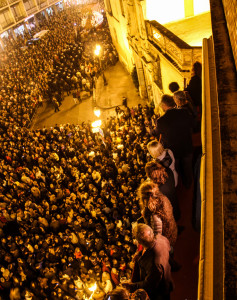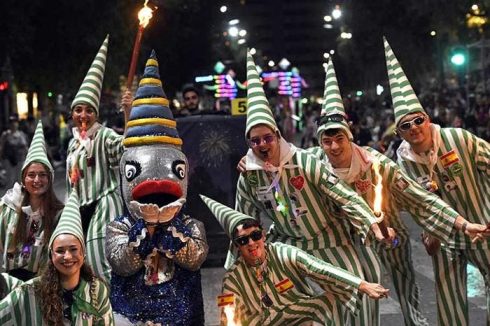IT seems almost impossible to describe Sevilla’s incredible Semana Santa processions without making them sound like a sinister Disneyland parade.
But I promised our guide Manni Coe that I would try, so try I shall. I joined Toma Tour’s special Semana Santa trip to Sevilla on the Holy Wednesday and have never witnessed anything quite like it.
We arrived as Sevilla was sleeping, it was the calm before the storm. Manni made the journey across some of the most beautiful Andalucian scenery pass by in what seemed like minutes, with his compelling explanations of the elegant Sevilla and the world-famous Easter processions.
He clearly felt passionate about this city, the capital of Andalucia, having lived in the centre for five years before deciding he simply couldn’t put his body through another 50 degree summer. As he is originally from Yorkshire, this is more than understandable.
We parked up on the edge of the centre, as all the roads were closed for Holy Week, a whole thriving city shut down for a week. Toma Tours had rented a balcony off a welcoming American-turned-Sevillian named Brad.
‘The largest balcony in Sevilla’, we were told. Now I’m not sure if this is certified, rubber-stamped fact, but it was absolutely massive at 30 metres. And wherever you stood provided views over the church and plaza of Cristo de Burgos.
Sevilla is home to 58 brotherhoods (hermandads), resulting in many, many processions – consisting of beautiful catholic sculptures of the Virgin Mary and Christ and often accompanied by music – throughout the week. At all times there are at least five processions making their way slowly through the streets.
I took the opportunity to explore Sevilla in the sunlight, before the Cristo de Burgos procession left the church that evening. Around every corner loomed another beautiful baroque church or a small plaza lined with orange trees and tapas bars.
After just half an hour I was adept at crossing processions, slipping behind someone else doing the same and darting across a gap in the nazarenos.
These are the people with pointed hoods and robes in the colour of their hermandad that walk behind the floats (pasos), numbering hundreds and often making the processions a mile long. They are usually led by someone holding a wooden cross, with several police officers in front to carve a way through the crowds.
The logistical organisation really was astounding, with half a million people on the streets (a million on Good Friday), processions cutting across the city centre a mile long and priceless religious floats involved. Despite this, my eagerness to see the cathedral led me far from the comfort of our candlelit balcony and before long I was walking in circles.
But with so many people on the streets creating a festival atmosphere, it was easy to get someone to point me back onto the right path. However, upon returning to our church and realising I was on the wrong side of the entrance, I began to see why my Spanish friends had first laughed when I told them I was going to Sevilla for Holy Week.
The plaza was now rammed and humming with the expectation of the masses, so I cut my losses and took an incredibly long way around the back of the church to our flat. In fact, the fervour was heightened as many processions had been rained off last year, to the misery and despair of hundreds of thousands.
Standing on a balcony up-high with vino blanco in one hand and freshly cut jamon iberico in the other is undoubtedly the perfect way to watch the elegant floats edge slowly out of the church door, swaying, with thousands of eyes glued to them.
Christ came first, followed by penitents bearing crosses, all to the sound of utter silence. The floats are hand-carved, beautiful and priceless and this is the only time of year they ever leave their church.
The sun was beginning to set, its rays shining through the burning incense and candles creating a wonderfully ethereal picture. Then after the hundreds of black nazarenos and the Virgin, bedecked with candles, flowers and silver, came the band, pumping the sound of spine-tingling drums and brass around the square.
 I immediately recognised the music as that which I had heard in the sports hall in Estepona when parking my car many evenings over the previous month. These processions are held across Andalucia and Spain, from the tiny pueblos to the big cities, but nowhere does it quite like Sevilla.
I immediately recognised the music as that which I had heard in the sports hall in Estepona when parking my car many evenings over the previous month. These processions are held across Andalucia and Spain, from the tiny pueblos to the big cities, but nowhere does it quite like Sevilla.
The music enraptured the thousands in the square, serenading the floats as they painstakingly turned a corner – a manoeuvre the carriers must have practised many times – and began their walk.
Within minutes of the Virgin disappearing down the road, drums from a different procession could be heard getting louder, and the crowds began to disperse and make way for this new line of nazarenos, this time clad in brown.
Everyone on our balcony stood speechless as the music cascaded across the streets and these enormous floats swayed back and forth. Of course, ‘float’ they did not. They can actually weigh several tonnes and the technique of swaying them to make it look like they are dancing is apparently amazingly tricky to master.
Amid the nazarenos were children, obviously buzzing from the being the centre of attention, dressed immaculately and each holding a bucket of sweets. Although at the rate they were eagerly launching them into the crowd they can’t have lasted very long.
Many other youngsters could be seen waiting tentatively at the edge of the procession holding balls of wax, begging nazarenos to pour candle wax onto their ball. Manni told us this is a competition between the local kids to end the night with the biggest ball.
I spotted one boy cheating though, pouring wax over a football, and immediately tried to report him to the wax ball authorities.
By now the sun was nearly set and the evening’s festivities were in full swing. I headed back down onto the streets and to another bigger plaza, cutting through the crowd to find the best vantage point.
From here a different Virgin was paraded before us and the atmosphere on the streets was one of hushed awe as she arrived in the square. But once she was there and the band struck up, clapping broke out and the intensity rose another notch.
I found respite away from the square, quenching my thirst with beer purchased from a street-side tavern at 50 cents a cup, before picking my way back towards our balcony one final time, ready to witness the much-vaunted return of the procession.
The streetlights were switched off and candles lit the majestic scene as thousands crowded around the church. As the Christ stopped one last time, a saetaro began singing from our balcony. The saeta is a gypsy prayer that has become a song through flamenco, it is notoriously difficult to sing and only heard in Holy Week.
To have this mesmerising song coming from our balcony, with the crowds below looking up in silence, was a stunning moment. Everything had been leading up to this.
Lines of nazarenos holding candles, musky incense burning, saetaro singing and the beautiful statues of Christ and the Virgin disappearing into the church, entrancing the thousands all around.
I could see why there were TV cameras in every square, sending this breath-taking footage to screens around Spain. But I can’t imagine it even comes close to being there, breathing it in and being a part of it.
If I haven’t managed to eloquently portray the wonder of Semana Santa in Sevilla, the least I can do is recommend everybody go and experience it for themselves.
For information on tours visit www.tomatours.com











Would love to experience it. Maybe next year. Nice review.
The experience I had in Seville during Semana Santa was indeed awesome and unforgettable.
Beautifully captured… To stand next to the gypsy singer must have been great…
This is something i must get to experience.next year i hope.
I love Semana Santa in Seville. Last year I enjoyed it from a balcony too, check it through http://www.mybalcony.com